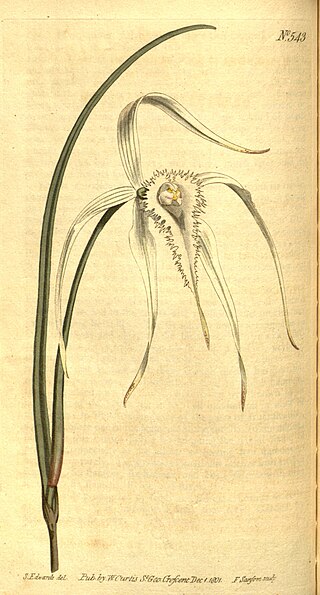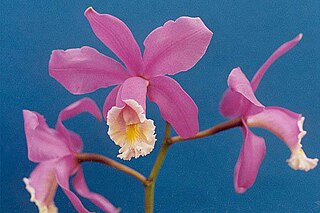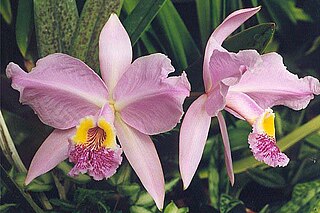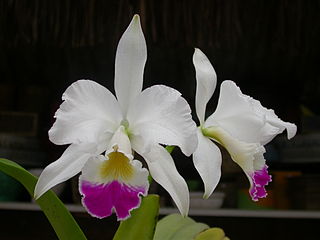
Laelia anceps is a species of orchid found in Mexico and Guatemala.

Laelia albida is the most northerly-growing laelia in Mexico. This epiphytic orchid bears ten or more small (5 cm) pale pink flowers on a half-meter terminal inflorescence in late winter to early spring. It is cold-tolerant close to freezing in the winter and needs to be kept dry until new vegetative growth is seen in late spring. It seems to do much better mounted on cork or hardwood than potted.

Cattleya trianae, also known as Flor de Mayo or "Christmas orchid", is a plant of the family Orchidaceae. It grows as an epiphytic orchid, with succulent leaves, endemic to Colombia where it was nominated as the national flower in November 1936. That year, the National Academy of History of Argentina asked the Latin American countries to participate in an exhibition with the representative flowers of each country. The Colombian government gave the botanist Emilio Robledo the task to designate the most representative flowering plant of the country.

Epidendrum ciliare, synonyms including Coilostylis ciliaris is a species of orchid. It is known as the fringed star orchid. It has a wide distribution from Mexico through Central America and the Caribbean to northern and western South America.

Epidendrum nocturnum is the type species of the genus Epidendrum of the Orchidaceae . The species occurs in Florida, Bahamas, West Indies, Belize, Central America to northern Brazil and the Guyanas. Epidendrum nocturnum is common in South Florida.

Brassavola cucullata, common name daddy long-legs orchid, is a species of orchid native to Mexico, Belize, Central America, the West Indies and northern South America.

Brassavola nodosa is a small, tough species of orchid native to Mexico, Central America, the West Indies, and northern South America. It is also known as "lady of the night" orchid due to its citrus and gardenia-like fragrance which begins in the early evening. It has been widely hybridized and cultivated for its showy flowers and pleasing scent.

Cattleya dormaniana, or Dorman's cattleya, is a bifoliate Cattleya species of orchid. The diploid chromosome number of C. dormaniana has been determined as 2n = 40.

Cattleya dowiana is a species of orchid. The diploid chromosome number of C. dowiana has been determined as 2n = 40; the haploid chromosome number has been determined as n = 20.

Cattleya forbesii, or Forbes' cattleya, is a species of orchid. The diploid chromosome number of C. forbesii has been determined as 2n = 54–60.

Cattleya guttata is a bifoliate Cattleya species of orchid. The diploid chromosome number of C. guttata has been determined as 2n = 40.

Cattleya harrisoniana is a bifoliate Cattleya species of orchid. The diploid chromosome number of C. harrisoniana has been determined as 2n = 40. The haploid chromosome number of C. harrisoniana has been determined as n = 20.

Cattleya intermedia, the intermediate cattleya, is a bifoliate Cattleya species of orchid. The diploid chromosome number of C. intermedia has been determined as 2n = 40.

Cattleya lueddemanniana is a labiate Cattleya species of orchid. The diploid chromosome number of C. lueddemanniana has been determined as 2n = 40.

Cattleya mossiae, commonly known as the Easter orchid, is a species of labiate Cattleya orchid. The white-flowered form is sometimes known as Cattleya wagneri. The diploid chromosome number of C. mossiae has been determined as 2n = 40. The haploid chromosome number has been determined as n = 20.

Cattleya percivaliana is a species of orchid. It shares the common name of "Christmas Orchid" with C. trianae and Angraecum sesquipedale. The diploid chromosome number of C. percivaliana has been determined as 2n = 40. The haploid chromosome number has been determined as n = 20.

Cattleya walkeriana, or Walker's cattleya, is a species of orchid. It differs from most species of Cattleya by having inflorescences which arise from the rhizome instead of from the apex of the pseudobulb. In its native habitat it grows as either an epiphyte or a lithophyte, sometimes in full sun, at elevations up to 2000 meters. Pseudobulbs are relatively short, bulbous or fusiform, with one or two ovate leaves at the apex. Inflorescence is one- or few-flowered, about 8" (20 cm) tall. Flowers are 4-5" (9-12 cm) across.

Cattleya warneri is a labiate Cattleya species of orchid. The diploid chromosome number of C. warneri has been determined as 2n = 40.

Guarianthe aurantiaca is a species of orchid. It is widespread across much of Mexico, south to Costa Rica. The diploid chromosome number of G. aurantiaca has been determined as 2n = 40.
Epidendrum cochlidium is a neotropical orchid which can grow both terrestrially and epiphytically in Peru and Venezuela at altitudes ranging from 1.2 km to 2.9 km.



















